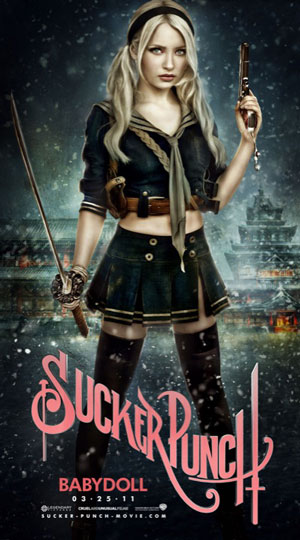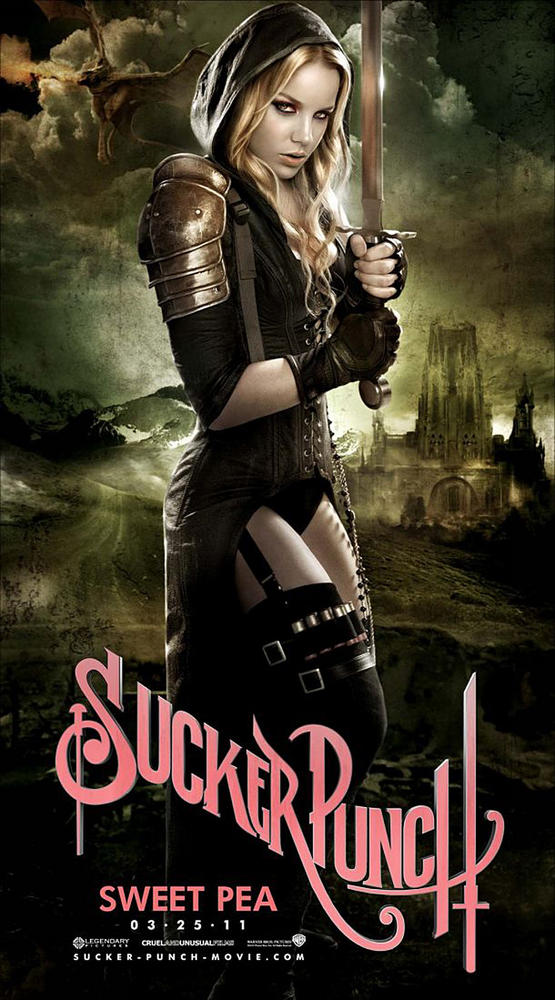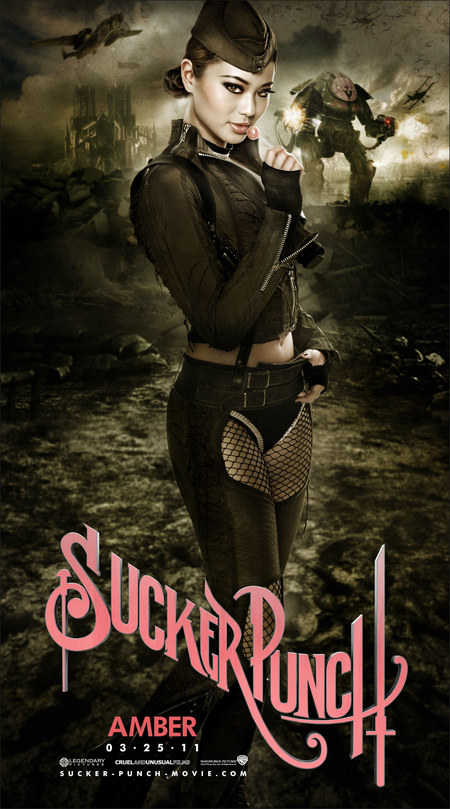 There’s something wonderfully insane about making a film that engages two completely contradictory instincts, two wholly disparate notions, and attempts to tackle the impossible task of reconciling them within the same story. Zach Snyder has done exactly that with Sucker Punch, and while it would be disingenuous for any honest person to posit that he was successful in doing so, there is something fascinating about watching the struggle. The thematic and aesthetic battle going on below the surface of the actual battles in Sucker Punch is akin to combining oil and water- they’re never going to mix properly, but you make some beautiful patterns and forms by trying.
There’s something wonderfully insane about making a film that engages two completely contradictory instincts, two wholly disparate notions, and attempts to tackle the impossible task of reconciling them within the same story. Zach Snyder has done exactly that with Sucker Punch, and while it would be disingenuous for any honest person to posit that he was successful in doing so, there is something fascinating about watching the struggle. The thematic and aesthetic battle going on below the surface of the actual battles in Sucker Punch is akin to combining oil and water- they’re never going to mix properly, but you make some beautiful patterns and forms by trying.
Sucker Punch is a film that desperately wants to operate on the same terms as a fairy tale or a parable, and this is made clear both by the stage and curtain through which we pass to enter the story, and by the dialog-less opening sequence. Synder immediately engages his expert handle on slow-motion, high-contrast photography, and thunderously operatic blocking to mythologize the event that will send our hero Baby Doll to the insane asylum in which her fantasies will unfurl. Unfortunately, after the film settles down from its beautiful prologue-ish opening, characters eventually start to open their mouths.
If Sucker Punch has any element that is outright bad, it’s definitely the dialogue, and it’s a shame it couldn’t have played out as a more operatic, extended-music-video-style movie. The soundtrack is absolutely fantastic, and every re-imagined pop track flows perfectly with the visuals, without restraining the film’s picture editing rhythm (a danger when you cut to pop music). Sure, the upbeat percussive treatment on most of the songs is usually endemic to the worst of shallow pop music and hip hop, but here it works as a rhythmic spine for a film that is uninhibited with its transitions to different levels of reality. While the score and soundtrack are not quite as sublimely integrated as they are in something like Inception (an oddly comparable movie I’ll discuss more later), they are integral to the flow of the film. In fact, it’s hard to feel like the last-minute removal of a half-dozen musical numbers from the film wasn’t a crippling choice, since Sucker Punch was obviously conceived as a sonic experience as much as a visual one.
Regardless, music is key from the very first moments, when we witness a tragedy ultimately caused by the explicitly evil intentions of Baby Doll’s step-father; a thieving, murderous, and sexually malevolent demon of paternal oppression. Once the step-father uses the tragedy as an excuse to hand her off to the madhouse (and to be forever quieted by a lobotomy), that father figure becomes three- a sleazy warden, an abusive cook, and a debauch guard. There is also the looming specter of the doctor who will come to lobotomize Baby Doll, and a female psychologist- all together these figures watch over a group of imprisoned women that Baby Doll joins when she arrives. The vast majority of the film takes place in her heightened fantasy version of the asylum though, which we enter mere moments after she’s brought in to the “real world” version.
Within the fantasy world, Baby Doll’s fellow captives become burlesque-styled prostitutes and dancers living in a brothel run by the same figures in the asylum, except the sleazy warden has become a sleazy pimp, the guard has become a routinely-visiting politician, and so on and so forth. Wizard of Oz is the mold here, but the relationship is not clearly 1:1 because the lines between fantasy and reality are much blurrier in Sucker Punch than in Oz, with the latter ultimately being a self-contained fantasy with allegorical characters. Here, what we learn about the characters and their dynamics is assumed to be true in the real world, even if the surroundings and their exact stations in life are not.
 What adds the extra layer of spectacle to Snyder’s story though and serves as the hook for the whole thing, is that within Baby Doll’s personal Oz, she also dances herself down a series of rabbit holes into other worlds. She discovers –in the Oz-level fantasy– that she has a supernaturally entrancing ability to dance, which manifests itself to the viewer as epic journeys through several distinct wonderlands. This is to say: while Baby Doll performs and mesmerizes those around her, we see a second layer of fantasy in her head that seems to represent the dancing as an adventurous crusade through a medieval battle, or a steam-punk vision of a WWII operation, or a futuristic train heist. Baby Doll employs this gift in a scheme with the other girls to escape the brothel. So begins a sequence of trips through the various wonderlands where the girls steal mystical items (guided by a reoccurring, healthy father figure), while back down in Oz Baby Doll is simply distracting the prison staff with her dancing while the other girls snatch the real-world, utilitarian versions of those mystical items.
What adds the extra layer of spectacle to Snyder’s story though and serves as the hook for the whole thing, is that within Baby Doll’s personal Oz, she also dances herself down a series of rabbit holes into other worlds. She discovers –in the Oz-level fantasy– that she has a supernaturally entrancing ability to dance, which manifests itself to the viewer as epic journeys through several distinct wonderlands. This is to say: while Baby Doll performs and mesmerizes those around her, we see a second layer of fantasy in her head that seems to represent the dancing as an adventurous crusade through a medieval battle, or a steam-punk vision of a WWII operation, or a futuristic train heist. Baby Doll employs this gift in a scheme with the other girls to escape the brothel. So begins a sequence of trips through the various wonderlands where the girls steal mystical items (guided by a reoccurring, healthy father figure), while back down in Oz Baby Doll is simply distracting the prison staff with her dancing while the other girls snatch the real-world, utilitarian versions of those mystical items.
There’s no doubt that the story and the film were constructed around the idea of hopping from one fantasy scenario to the next, but it’s very clear that Snyder had genuine thematic concerns as well. These girls are all beautiful, and by the nature of Baby Doll’s brothel-fantasy are typically clad in full-burlesque gear, and yet this is not typically thoughtless exploitation. The fragmented presence of several different unhealthy father figures is not exactly subtle but you also have the more complex presence of a mother-figure who, through the manipulation and more sub-surface abuse of the men in power, has become an enabler of the system. Her efforts to support the girls have been beaten down until she’s taken on a dubious role of “teaching the girls to survive”- by objectifying themselves even more. Even the names of the character reflect the condescending and marginalizing shorthand that even loving men use to shift the power balance. These situations engage the sad scenarios that occur subtly in the most “normal” of nuclear families, and more blatantly in the nastier ends of the sex industry.
For all the carelessness in the dialogue and plotting, Snyder demonstrates a strong understanding of the balance between exploiting and empowering women. So while the themes of male dominance and female subversion of that power are not necessarily expertly paid off, they’re also not just paying lip service to the ideas so the film can mindlessly objectify its protagonists. Rather, they accentuate the fantasy scenarios that give the female heroes license to kick ass on their own terms. Yes, they look sexy doing it, but being in control of one’s sexuality and wrecking the day of a steampunk Nazi or a dragon are not mutually exclusive. What’s important is that Snyder’s lens is fetishistic of the action itself, and not of the women involved. Even the burlesque costuming in the Oz-level fantasies reflect a fashion sensibility that was still about accentuating femininity, rather than raw masturbatory spectacle. It’s unnecessarily hyperbolic to call Sucker Punch a feminist film, but it’s not careless in its treatment of women and their image, and it’s most certainly empowering.
Naturally, it’s that empowering kickass action where Snyder excels. His visual kinetics are more varied than ever, and while he is no more restrained in his use of slow-motion, it is not his only trick. Snyder uses the segmented nature of the film to take different approaches, and from wonderland to wonderland his camera technique shifts as dramatically as the locations and their designs. While one sequence is filmed in an extremely extended single-take shot that uses nothing but shifts in speed and composition to be dynamic, another is filmed with little or no slow-motion at all, relying on handheld camera work to immerse the viewer. These sequences are aggressive, violent, and huge but maintain geography and fluidity as key principles, proving that there is no better blockbuster visualist working in Hollywood right now. Not Bay, not Cameron, not Scott. If Snyder ever makes the coherence of his script a larger priority then he could be on the path to becoming one of the important big-budget auteurs.
He’s got a long way to go however, because though the sexual politics ultimately fare well by being present, the thematic concerns in Sucker Punch are much more hit and miss. There are themes of self-sacrifice and sorority in the face of oppression, but none of them pay off strongly in the final act. There’s also not much that can be said for the performances of Sucker Punch, because while there is some kind of chemistry between the main girls, several of them are left almost entirely blank. Emily Browning as Baby Doll certainly leaves an impression by being genuinely charming in her front-and-center role, while Jena Malone as Rocket and Abbie Cornish as her sister Sweet Pea manage to translate their sibling-tension into some character dimension. Hudgens, Chung, and Gugino all do what the script demands of them but in the case of the former two, that is virtually nothing. They’re all chewing on dialogue that ranges from mediocre to bad bad, but most of it is utilitarian plot-driving stuff anyway. Again, this could have really been transcendent as an outright musical or opera.
 The sum of those flaws is a messiness that prevents the film from being a wholly satisfactory narrative experience, but it doesn’t preclude it from being beautiful, fun, and worthwhile. Here’s the thing- the idea that you need a strong connection to the characters in order to enjoy action scenes on a visceral, adrenaline level is utter horseshit. The constant fetishizing of B-action and exploitation films that pay no attention to character make it clear that one can enjoy spectacle regardless. Obviously action is improved with character investment, but weak characterization and dialogue are flaws that can exist without sinking a film if the overall themes are consistently integrated and culminate in a satisfying manner. Sucker Punch simply does not manage that. So yes, while it sits on the razor’s edge of being a good movie, it’s ultimately not going to fall on the memorable side. The idea that it is inherently disengaging or even boring is ludicrous though. Your personal mileage may vary, but there’s nothing that objectively prevents the film from being a roaring action experience for those willing to roll with it.
The sum of those flaws is a messiness that prevents the film from being a wholly satisfactory narrative experience, but it doesn’t preclude it from being beautiful, fun, and worthwhile. Here’s the thing- the idea that you need a strong connection to the characters in order to enjoy action scenes on a visceral, adrenaline level is utter horseshit. The constant fetishizing of B-action and exploitation films that pay no attention to character make it clear that one can enjoy spectacle regardless. Obviously action is improved with character investment, but weak characterization and dialogue are flaws that can exist without sinking a film if the overall themes are consistently integrated and culminate in a satisfying manner. Sucker Punch simply does not manage that. So yes, while it sits on the razor’s edge of being a good movie, it’s ultimately not going to fall on the memorable side. The idea that it is inherently disengaging or even boring is ludicrous though. Your personal mileage may vary, but there’s nothing that objectively prevents the film from being a roaring action experience for those willing to roll with it.
Ultimately the clear ambition of the project does add some frustration, especially when contrasted with similar projects with better results. Interestingly, the multi-layered fantasy/dream structure is only one of several characteristics of Sucker Punch that invites comparisons to Chris Nolan’s Inception, one such similar project. Aside from being released within a year of each other from the same studio, both are the result of a director’s clout with said studio translating into an opportunity to play out his purest vision with full resources. They also both employ multiple layers of dreams or fantasy to tie together trips though different genres. Nolan’s blank check seemed to arrive at the perfect moment in his career, and he constructed a post-Matrix heist film that was not only exciting, but was more emotionally satisfying than anything he’d ever done. If Snyder’s shot had come after he’d reached the same level of emotional control over his filmmaking and as sophisticated a handle on character in his writing, then perhaps we’d be left with a wonderful pair of films- two sides of a coin. It’s not hard to imagine the scenario where we were left with one film representing the architecturally precise, left-brained take on cinematic fantasy, while the other was the right-brained explosion of a teenage sketchbook and its genre-blending doodles onto the screen. The lack of a strong thematic core to Sucker Punch means the two-sides of the coin also represent success and failure.
Ultimately what you take from Sucker Punch will depend on what you demand from the films you watch, and what they must accomplish to satisfy you. There is a flawed and exciting journey to be taken through one man’s vision of the genre-film landscape, and there is nothing inherently insulting or cynical about it. Sucker Punch fails, but it doesn’t insult its audience, or rely on cynical assumptions about them to function. Its the kind of failure that is disappointing but affirming, and it suggests that a talented filmmaker is only a good script away from blowing us away. The onus is now on Snyder to strengthen his grasp on writing or screenplay selection, because a fun failure like Sucker Punch is only interesting once.
Rating: 




Out of a Possible 5 Stars
DISCUSS THIS on the CHUD Message Board
&
Like / Share it on Facebook (above or below) if you think it’s great!